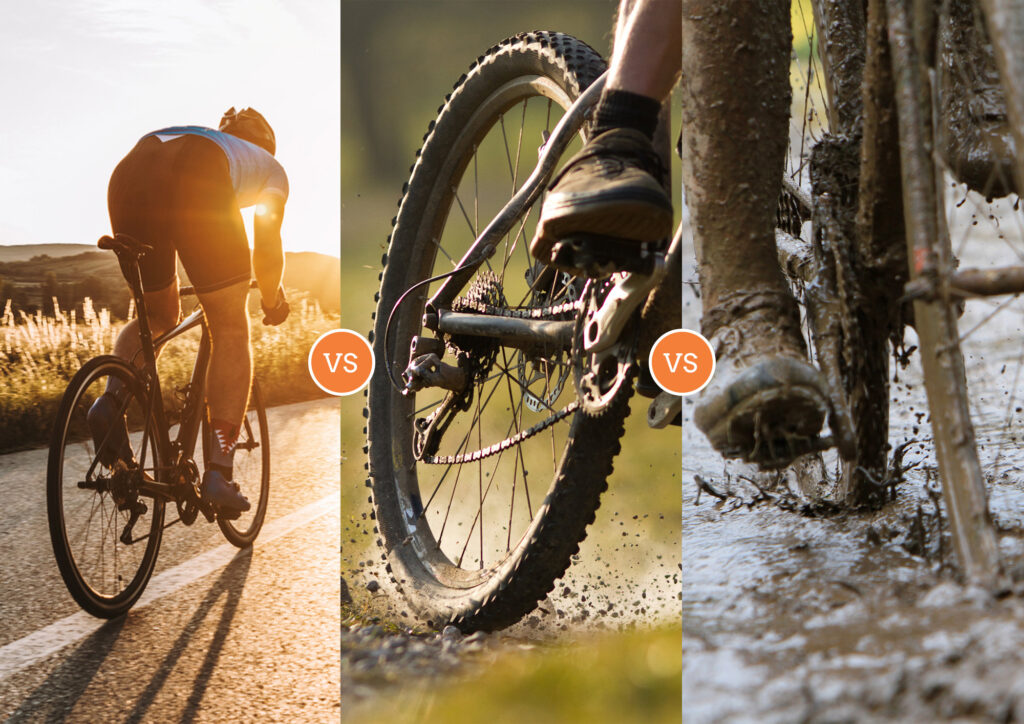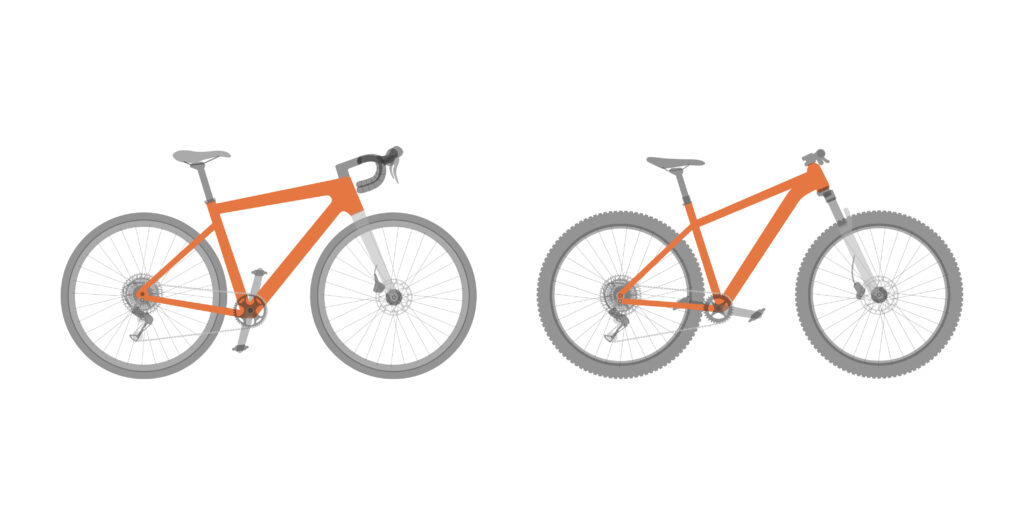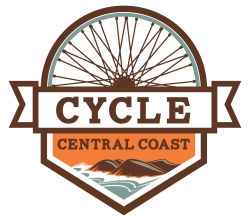Riding a Gravel Bike vs. Road Bike on the Central Coast
While the Central Coast’s cycling roads are the pinnacle of road cycling experiences for paved-route enthusiasts, you’ll also see riders on gravel bikes cruising Highway 1, basking in the stunning landscapes and picturesque hills along Highway 1. Gravel bike vs. road bike: what’s the difference? What do you need to know as you consider buying your next bike? Which bike to bring on your next trip to Cambria and the Central Coast?
In this blog, we’ll go through all you need to know about the differences and similarities between road bikes and gravel bikes and what factors you should consider as you plan your next adventure out to the Central Coast.

Road Bike vs. Gravel Bike vs. Cyclocross Bike
What Is a Road Bike?
A road bike is specifically designed for riding on smooth paved surfaces—such as Highway 1—typically emphasizing speed, efficiency, and aerodynamics.
In comparison to a gravel bike, a road bike has less versatility to handle off-road or gravel terrains and may not have the tire clearance or frame strength necessary for rugged conditions. Road bikes are similar to cyclocross bikes but aren’t as adept at handle rougher surfaces, incorporating narrower tire clearance, and sacrificing durability for speed on the road rather than rugged surfaces.
These bikes are best for all-road routes such as our Avila Beach Route and Ragged Point Route.
What Is a Gravel Bike?
A gravel bike, also known as an adventure bike, is designed to excel on various terrains, including gravel roads, dirt trails, and even some light off-road trails. It strikes a balance between the speed and efficiency of a road bike and the durability and versatility of a cyclocross bike.
Gravel bikes feature wider tires with more aggressive tread patterns for enhanced grip, a more relaxed geometry for increased stability, and often include mounting points for accessories like racks and fenders. Unlike a road bike, a gravel bike is equipped to handle rougher and unpaved surfaces, making it ideal for riders seeking exploration and adventure beyond traditional road cycling routes.
Gravel bikes thrive on routes such as the San Simeon Creek Climb.
What Is a Cyclocross Bike?
While this guide focuses on road bikes and gravel bikes, another type of bike commonly associated with (and may be confused with) them is a cyclocross bike.
A cyclocross bike is a versatile bike designed for cyclocross racing, which involves a combination of off-road sections, obstacles, and quick dismounts and remounts. It shares similarities with both road bikes and gravel bikes but has specific characteristics that set it apart.
Cyclocross bikes typically have a more aggressive geometry similar to road bikes, allowing for quick handling and efficient power transfer. However, they differ from road bikes by offering wider tire clearance and more rugged components to handle off-road conditions.
While a gravel bike is designed for varied terrain and long-distance adventures, a cyclocross bike is optimized for the unique demands of cyclocross racing, combining agility, durability, and off-road capability.
Basic Differences Between Road Bikes & Gravel Bikes
Gravel bikes and road bikes are generally designed for different purposes. Road bikes prioritize speed, efficiency, and smooth handling on paved surfaces, while gravel bikes are versatile machines built to tackle diverse terrains such as gravel and off-road trails. Road bikes are optimized for high-speed riding on asphalt, while gravel bikes offer stability and durability to conquer the road when it gets rough.
Road bikes’ sleek frames and smooth tires optimize the aerodynamics of riding while gripping the asphalt. On the other hand, the heavier tires of gravel bikes are built to tackle diverse terrains and offer enhanced traction on rocky surfaces, making them well-suited for off-road adventures.
Physical Differences Between Road Bikes & Gravel Bikes
Wheels & Tires
Wheel and tire specifications play a crucial role in distinguishing gravel bikes from road bikes. Gravel bikes feature wider tires with more substantial tread patterns, allowing for better traction and grip on loose surfaces. Road bikes, on the other hand, come with narrower tires designed for reduced rolling resistance and smooth pavement grip.

When comparing road bikes and gravel bikes, tire width plays a crucial role. Road bikes typically have narrower tires, optimizing speed and efficiency on smooth pavement. In contrast, gravel bikes feature wider tires, offering increased stability and improved traction on uneven gravel routes, making them ideal for exploring the rugged terrain along the Central Coast, including the gravel routes stemming off Highway 1.
Additionally, considering the unpredictable nature of off-road riding, many gravel bike enthusiasts opt for tubeless setups, which provide added puncture resistance and allow for lower tire pressures, further enhancing grip and comfort on gravel surfaces.
Frame Shape & Geometry
Frame geometry is another differentiating factor between gravel bikes and road bikes.

Gravel bikes generally have more relaxed geometry with a slightly longer wheelbase, a lower bottom bracket, and a slacker head tube angle. This design promotes stability, comfort, and handling on varied terrains. Road bikes prioritize aerodynamics and efficiency with more aggressive geometry, contributing to increased speed on paved roads.
The geometry of a bike, including factors such as head tube angle, bottom bracket height, and wheelbase, greatly influences its performance and handling characteristics. Gravel bike design allows for a comfortable riding position and enhances the bike’s ability to navigate challenging conditions, ensuring a smooth and enjoyable experience along the varied terrains of the Central Coast.
Frame Materials
Both gravel bikes and road bikes are available in a range of frame materials, including carbon fiber, aluminum, and steel. Carbon fiber frames offer lightweight and stiffness, ideal for maximizing speed and performance on road bikes. Gravel bikes often incorporate materials like aluminum and steel for added durability and comfort during off-road adventures.
Frame materials can directly influence a cycling experience. Carbon fiber frames provide lightweight construction, ideal for maximizing speed and efficiency on paved roads, while aluminum frames offer a balance of affordability and durability.
Steel frames, known for their smooth and comfortable ride quality, excel in absorbing vibrations and are well-suited for long-distance adventures on gravel terrain, allowing riders to experience the scenic beauty of the Central Coast in utmost comfort and style.
Suspension Systems
Road bikes typically do not feature suspension systems, as they are designed for smooth pavement. Gravel bikes, on the other hand, may come with front suspension forks or rear suspension systems to absorb shocks and enhance comfort on rough terrain. Considering the road conditions along Highway 1, the presence of suspension on gravel bikes can provide a smoother ride on certain sections.

Suspension systems can greatly enhance the off-road riding experience by absorbing bumps, vibrations, and impacts, providing a smoother and more controlled ride. When tackling the diverse terrains of the Central Coast, including the gravel routes off Highway 1, the presence of suspension becomes particularly advantageous in handling rough surfaces and maintaining traction.
The varying road conditions along the Central Coast make suspension an important consideration, allowing riders to confidently navigate uneven terrain, enjoy better stability, and make the most of their gravel cycling adventures.
Gears & Braking
Gravel bikes and road bikes differ in their gearing and braking systems. Gravel bikes often feature wider gear ranges and lower gears to handle steep inclines and challenging off-road conditions. Road bikes prioritize higher gear ratios for efficient pedaling on smooth roads. Braking systems also vary, with disc brakes being more common on gravel bikes for reliable stopping power in all conditions.

The choice of drivetrains, gearing, and braking systems on gravel bikes and road bikes can significantly impact their performance in different riding conditions. Gravel bikes often feature wider gear ranges and lower gears, allowing riders to conquer steep climbs and navigate challenging off-road sections along Highway 1 with ease. Appropriate gearing is crucial for maintaining momentum during climbs and ensuring controlled descents, making it an essential consideration for an enjoyable and efficient cycling experience on the diverse terrain of the Central Coast.
Seats & Handlebars
Gravel bikes and road bikes feature different handlebar designs tailored to their respective purposes.

Road bikes commonly have drop handlebars (drop bars) that promote an aerodynamic riding position, allowing riders to maximize speed and efficiency on paved roads. Gravel bikes often come with wider handlebars, providing better control and stability when navigating rough terrain. The wider grip also enhances maneuverability during technical sections. Choosing the right handlebar design based on personal preference and riding style is crucial for an enjoyable experience.
Seatpost compliance refers to the ability of the seatpost to absorb vibrations and impacts, contributing to overall comfort during rides. Gravel bikes typically incorporate seatposts with more compliance, using materials like carbon fiber or specialized designs to dampen road vibrations and reduce fatigue. Road bikes, on the other hand, may prioritize stiffness for efficient power transfer on smooth surfaces.
When riding along the Central Coast’s diverse terrain, investing in a seatpost that offers some level of compliance can enhance comfort, particularly on rougher sections.
Mounting Points
Both gravel bikes and road bikes come with mounting points that allow riders to attach various accessories. Gravel bikes often feature additional mounting points for racks, bags, and water bottle holders, catering to the needs of long-distance or adventure riders who require extra storage capacity. Road bikes, being more focused on speed and minimalism, may have fewer mounting options.

When exploring the Central Coast along Highway 1, additional mounting points become particularly valuable for extended rides, providing the utility needed to carry supplies and essentials for a comfortable and enjoyable cycling adventure. Whether it’s hydration, snacks, or extra gear, having the option to securely attach accessories enhances the practicality and preparedness for riders exploring the stunning coastal beauty of the region.
Pedals
Pedal choice is a personal preference that can significantly impact the riding experience. Both gravel bikes and road bikes offer various pedal options.
- Clipless pedals, popular among road cyclists, provide a secure and efficient connection between the shoe and pedal, optimizing power transfer.
- Platform pedals, which have a larger platform and allow riders to use regular shoes, are commonly found on gravel bikes, offering convenience and versatility.
- Hybrid pedals that combine clipless and platform features also exist, catering to riders who desire flexibility.
When choosing pedals for Central Coast riding, consider your comfort level, skill, and terrain preferences to ensure compatibility and maximize performance.

How a Road Bike’s Design Optimizes for Paved Road Cycling
Road bikes are purpose-built machines designed to excel on paved roads. Their design focuses on aerodynamics, lightweight construction, and efficiency.
With narrow tires, aggressive geometry, and a rigid frame, road bikes allow riders to achieve high speeds and maintain a streamlined position. They are optimized for smooth pavement, making them the ideal choice for road cycling enthusiasts and those seeking speed and precision on the Central Coast’s predominantly paved routes.
Road bikes are engineered to provide a responsive and fast ride on smooth roads. Their lightweight frames and aerodynamic profiles minimize wind resistance, allowing riders to achieve higher speeds with less effort. The narrow, slick tires of road bikes offer reduced rolling resistance, optimizing efficiency and maximizing speed on paved surfaces.
If you’re looking to clock miles and focus on speed along Highway 1, a road bike is an excellent choice. When considering Central Coast riding, it’s important to acknowledge that road bikes may face limited terrain diversity along Highway 1.
Can I Ride My Road Bike on Gravel Terrain?
While road bikes are optimized for paved roads, it is possible to ride them on gravel terrain to a certain extent. However, there are important considerations to keep in mind.
The narrow tires and rigid frames of road bikes make them less suitable for rough and loose surfaces. Gravel roads can be unpredictable, with uneven terrain, loose gravel, and potential hazards. Riding a road bike on gravel increases the risk of punctures, reduced traction, and compromised control.
When taking a road bike onto gravel terrain, riders may encounter challenges such as limited grip, especially during turns or when braking suddenly. The narrow tires are more prone to sinking into loose gravel or getting caught in potholes, potentially leading to accidents or damage to the bike. Additionally, the rigid frame of a road bike may transmit more vibrations and impact forces, causing discomfort and fatigue during long rides on gravel.
Considering the Central Coast riding experience along Highway 1, caution is advised when considering using a road bike on gravel terrain. While there are stretches of paved roads, there are also gravel sections, particularly on less maintained or remote routes.
To fully enjoy the beauty and diversity of the Central Coast, it is recommended to opt for a bike that is specifically designed for mixed surfaces, such as a gravel bike, which offers better stability, control, and comfort on varied terrains.

How a Gravel Bike’s Design Optimizes for Gravel or Off-Road Cycling
Gravel bikes are purpose-built machines that prioritize versatility and performance on mixed surfaces. These bikes are designed to handle both paved roads and rougher terrains like gravel, dirt, and even light off-road trails. They blend features from road bikes and mountain bikes to offer a balanced and capable riding experience across diverse conditions. Gravel bikes typically have wider tires, more relaxed frame geometry, and additional clearance for mud and debris.
Gravel bikes excel in their ability to handle a variety of surfaces. The wider tires provide enhanced traction and stability on gravel, while still maintaining efficiency on pavement.
The frame geometry of gravel bikes offers a more comfortable and stable riding position, allowing riders to tackle long distances and rougher terrain with confidence. Gravel bikes also often come with mounts for racks and bags, allowing for extended trips and the ability to carry essential gear.
Riding a gravel bike along the Central Coast, especially along Highway 1, offers the opportunity to explore the region’s diverse landscapes. From the scenic coastal roads to the gravel paths that lead to hidden gems, gravel bikes provide the versatility needed to fully appreciate the beauty of the Central Coast.
With the ability to transition seamlessly between pavement and gravel, riders can venture off the beaten path, discover remote coastal viewpoints, and experience the thrill of riding in this breathtaking setting.
Can I Ride My Gravel Bike on Paved Terrain?
Gravel bikes are designed to perform well on both gravel and paved surfaces. While they may not match the speed and efficiency of road bikes on smooth roads, gravel bikes can still maintain a comfortable and enjoyable ride on pavement.
While gravel bikes excel on mixed surfaces and off-road terrains, there are trade-offs and potential limitations when it comes to using them exclusively on paved roads. The wider and more robust tires, along with the geometry and components optimized for off-road riding, may result in slightly slower speeds and less efficient performance compared to dedicated road bikes on smooth asphalt surfaces.
Choose Your Bike, Ride From Cambria
Understanding the key differences between gravel bikes and road bikes is essential for cyclists looking to explore the Central Coast’s stunning landscapes and diverse terrains. While road bikes excel on smooth pavement and offer high-speed capabilities, gravel bikes provide versatility, comfort, and enhanced traction for adventurous rides on gravel roads and trails.
Choose your bike, book your stay in Cambria, and be captivated as you embark on a memorable cycling experience and soak in the wonders of Highway 1 and coastal gravel roads.

